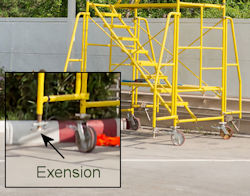Mobile Scaffolds
A mobile scaffold is a powered or non-powered, portable, caster or wheel-mounted supported scaffold. Mobile scaffolds constructed of tube and coupler components or of fabricated frames should conform to design, construction and loading requirements for those scaffolds.
- Ensure scaffolds are braced by cross, horizontal or diagonal braces, or combination thereof, to prevent racking or collapse, and that vertical members are secured together laterally so that vertical members are squared and aligned.
- Make sure scaffolds are plumb, level and squared and that all brace connections are secured.
- Make sure caster and wheel stems are pinned or otherwise secured in scaffold legs.
- Ensure platforms do not extend past the base supports unless outrigger frames or equivalent devices are used to ensure stability.
- Make sure that, while in a stationary position, casters and wheels are locked with a positive wheel and/or wheel and swivel locks, or equivalent means, to prevent movement. Note: A rolling scaffold load capacity is limited by the weight its casters can support.
- Check that employees are not allowed to ride on a mobile scaffold unless strict controls are followed (level and unobstructed surfaces, a height ratio to width of not more than two to one, slow speed of movement, confinement of employees within the scaffold frame, etc.)
- When manual force is used to move the scaffold, make sure the force is applied as close to the base as practicable, but no more than 5 feet above the supporting surface (i.e., scaffold base or wheels when a powered system is used).
- Make sure powered systems used to propel mobile scaffolds are designed for such use.
- Ensure forklifts, trucks, similar motor vehicles or add-on motors are not used to propel scaffolds unless the scaffold is designed for such propulsion systems.
Knowledge Check Choose the best answer for the question.
3-3. Check to verify platforms on mobile scaffolds do not extend past the base supports _____.
You forgot to answer the question!

